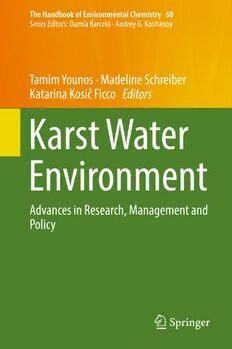
Karst Water Environment PDF
Preview Karst Water Environment
The Handbook of Environmental Chemistry 68 Series Editors: Damià Barceló · Andrey G. Kostianoy Tamim Younos · Madeline Schreiber Katarina Kosič Ficco Editors Karst Water Environment Advances in Research, Management and Policy The Handbook of Environmental Chemistry Founded by Otto Hutzinger Editors-in-Chief: Damià Barceló (cid:129) Andrey G. Kostianoy Volume 68 Advisory Board: Jacob de Boer, Philippe Garrigues, Ji-Dong Gu, Kevin C. Jones, Thomas P. Knepper, Alice Newton, Donald L. Sparks Moreinformationaboutthisseriesathttp://www.springer.com/series/698 Karst Water Environment Advances in Research, Management and Policy Volume Editors: Tamim Younos (cid:1) Madeline Schreiber (cid:1) Katarina Kosič Ficco With contributions by H. A. Barton (cid:1) J. L. Berglund (cid:1) F. Carrasco (cid:1) Y. Chen (cid:1) M. Doveri (cid:1) K. K. Ficco (cid:1) M. Ficco (cid:1) L. Florea (cid:1) R. Gogu (cid:1) T. Helms (cid:1) E. K. Herman (cid:1) O. S. Hershey (cid:1) A. Jiménez-Madrid (cid:1) J. Kallmeyer (cid:1) C. Martinez-Navarrete (cid:1) M. Menichini (cid:1) M. Petrič (cid:1) L. Piccini (cid:1) L. Shen (cid:1) Z. Stevanović (cid:1) E. Thaler (cid:1) L. Toran (cid:1) J. Van Brahana (cid:1) W. Yao (cid:1) T. Zhao Editors TamimYounos MadelineSchreiber GreenWater-InfrastructureAcademy DepartmentofGeosciences Washington,DC,USA VirginiaTech Blacksburg,Virginia,USA KatarinaKosičFicco NovaGorica,Slovenia ISSN1867-979X ISSN1616-864X (electronic) TheHandbookofEnvironmentalChemistry ISBN978-3-319-77367-4 ISBN978-3-319-77368-1 (eBook) https://doi.org/10.1007/978-3-319-77368-1 LibraryofCongressControlNumber:2018940190 ©SpringerInternationalPublishingAG,partofSpringerNature2019 Thisworkissubjecttocopyright.AllrightsarereservedbythePublisher,whetherthewholeorpartofthe materialisconcerned,specificallytherightsoftranslation,reprinting,reuseofillustrations,recitation, broadcasting,reproductiononmicrofilmsorinanyotherphysicalway,andtransmissionorinformation storageandretrieval,electronicadaptation,computersoftware,orbysimilarordissimilarmethodology nowknownorhereafterdeveloped. Theuseofgeneraldescriptivenames,registerednames,trademarks,servicemarks,etc.inthispublication doesnotimply,evenintheabsenceofaspecificstatement,thatsuchnamesareexemptfromtherelevant protectivelawsandregulationsandthereforefreeforgeneraluse. The publisher, the authors and the editors are safe to assume that the advice and information in this bookarebelievedtobetrueandaccurateatthedateofpublication.Neitherthepublishernortheauthorsor theeditorsgiveawarranty,expressorimplied,withrespecttothematerialcontainedhereinorforany errorsoromissionsthatmayhavebeenmade.Thepublisherremainsneutralwithregardtojurisdictional claimsinpublishedmapsandinstitutionalaffiliations. Printedonacid-freepaper ThisSpringerimprintispublishedbytheregisteredcompanySpringerInternationalPublishingAGpartof SpringerNature. Theregisteredcompanyaddressis:Gewerbestrasse11,6330Cham,Switzerland Editors-in-Chief Prof. Dr. Damià Barceló Prof. Dr. Andrey G. Kostianoy DepartmentofEnvironmentalChemistry P.P.ShirshovInstituteofOceanology IDAEA-CSIC RussianAcademyofSciences C/JordiGirona18–26, 36,NakhimovskyPr., 08034Barcelona,Spain 117997Moscow,Russia and [email protected] CatalanInstituteforWaterResearch(ICRA) H20Building ScientificandTechnologicalParkofthe UniversityofGirona EmiliGrahit,101, 17003Girona,Spain [email protected] Advisory Board Prof.Dr.JacobdeBoer IVM,VrijeUniversiteitAmsterdam,TheNetherlands Prof.Dr.PhilippeGarrigues UniversityofBordeaux,France Prof.Dr.Ji-DongGu TheUniversityofHongKong,China Prof.Dr.KevinC.Jones UniversityofLancaster,UnitedKingdom Prof.Dr.ThomasP.Knepper UniversityofAppliedScience,Fresenius,Idstein,Germany Prof.Dr.AliceNewton UniversityofAlgarve,Faro,Portugal Prof.Dr.DonaldL.Sparks PlantandSoilSciences,UniversityofDelaware,USA The Handbook of Environmental Chemistry Also Available Electronically TheHandbookofEnvironmentalChemistryisincludedinSpringer’seBookpackage EarthandEnvironmentalScience.Ifalibrarydoesnotoptforthewholepackage,the bookseriesmaybeboughtonasubscriptionbasis. ForallcustomerswhohaveastandingordertotheprintversionofTheHandbook of Environmental Chemistry, we offer free access to the electronic volumes of the SeriespublishedinthecurrentyearviaSpringerLink.Ifyoudonothaveaccess,you canstillviewthetableofcontentsofeachvolumeandtheabstractofeacharticleon SpringerLink(www.springerlink.com/content/110354/). Youwillfindinformationaboutthe –EditorialBoard –AimsandScope –InstructionsforAuthors –SampleContribution atspringer.com(www.springer.com/series/698). Allfiguressubmittedincolorarepublishedinfullcolorinthe electronicversionon SpringerLink. Aims and Scope Since 1980, The Handbook of Environmental Chemistry has provided sound and solid knowledge about environmental topics from a chemical perspective. Presenting a wide spectrum of viewpoints and approaches, the series now covers topics such as local and global changes of natural environment and climate; anthropogenicimpactontheenvironment;water,airandsoilpollution;remediation and waste characterization; environmental contaminants; biogeochemistry; geo- ecology;chemicalreactionsandprocesses;chemicalandbiologicaltransformations as well as physical transport of chemicals in the environment; or environmental modeling. A particular focus of the series lies on methodological advances in environmentalanalyticalchemistry. Series Preface With remarkable vision, Prof. Otto Hutzinger initiated The Handbook of Environ- mental Chemistry in 1980 and became the founding Editor-in-Chief. At that time, environmentalchemistrywasanemergingfield,aimingatacompletedescriptionof the Earth’s environment, encompassing the physical, chemical, biological, and geological transformations of chemical substances occurring on a local as well as aglobalscale.Environmentalchemistrywasintendedtoprovideanaccountofthe impact of man’s activities on the natural environment by describing observed changes. While a considerable amount of knowledge has been accumulated over the last three decades, as reflected in the more than 70 volumes of The Handbook of Environmental Chemistry, there are still many scientific and policy challenges ahead due to the complexity and interdisciplinary nature of the field. The series willthereforecontinuetoprovidecompilationsofcurrentknowledge.Contributions arewrittenbyleadingexpertswithpracticalexperienceintheirfields.TheHandbook of Environmental Chemistry grows with the increases in our scientific understand- ing,andprovidesavaluablesourcenotonlyforscientistsbutalsoforenvironmental managers and decision-makers. Today, the series covers a broad range of environ- mental topics from a chemical perspective, including methodological advances in environmentalanalyticalchemistry. In recent years, there has been a growing tendency to include subject matter of societalrelevanceinthebroadviewofenvironmentalchemistry.Topicsincludelife cycle analysis, environmental management, sustainable development, and socio- economic, legal and even political problems, among others. While these topics are of great importance for the development and acceptance of The Handbook of EnvironmentalChemistry,thepublisherandEditors-in-Chiefhavedecidedtokeep thehandbookessentiallyasourceofinformationon“hardsciences”withaparticular emphasis on chemistry, but also covering biology, geology, hydrology and engi- neeringasappliedtoenvironmentalsciences. Thevolumesoftheseriesarewrittenatanadvancedlevel,addressingtheneeds of both researchers and graduate students, as well as of people outside the field of ix x SeriesPreface “pure”chemistry,includingthoseinindustry,business,government,researchestab- lishments, and public interest groups. It would be very satisfying to see these volumes used as a basis for graduate courses in environmental chemistry. With its high standards of scientific quality and clarity, The Handbook of Environmental Chemistryprovidesasolidbasisfromwhichscientistscansharetheirknowledgeon the different aspects of environmental problems, presenting a wide spectrum of viewpointsandapproaches. TheHandbookofEnvironmentalChemistryisavailablebothinprintandonline viawww.springerlink.com/content/110354/.Articlesarepublishedonlineassoonas they have been approved for publication. Authors, Volume Editors and Editors-in- Chief are rewarded by the broad acceptance of The Handbook of Environmental Chemistrybythescientificcommunity,fromwhomsuggestionsfornewtopicstothe Editors-in-Chiefarealwaysverywelcome. DamiàBarceló AndreyG.Kostianoy Editors-in-Chief Preface Karst landscapes are formed by the long-term dissolution and erosion of soluble rocks. Karst terraneisgenerally characterizedby specific landforms suchascaves, sinkholes,sinkingstreams,anddirectinteractionbetweensurfaceandgroundwater systems. Depending on the specific type of karst topography, these landforms can eitherbeeasilyobservedorhiddenfromthesurface. Karst aquifers are important sources of drinking water worldwide, including manyregionsinNorthAmerica,Asia,Australia,andEurope.Thus,theirpreserva- tion and protection are of great importance. Assessment and management of karst aquiferscallsforspecificmethodologiesandsite-specificapplications.Karstscience is an interdisciplinary science that intersects geology, geomorphology, hydrology, physics, chemistry, biology, and other disciplines. The importance of including political and social sciences for management of karst aquifers is also becoming increasinglyrecognized.Despitearecentincreaseinknowledgeaboutthecomplex characterofkarstaquifers,theirprotection,preservation,andmanagementremaina majorchallengetoscientists,engineers,regulatoryagencies,andotherstakeholders. In order to highlight existing challenges in the field, this volume Karst Water Environment:AdvancesinResearch,ManagementandPolicypresentsadiscussion of the current state of knowledge on karst science, advances in karst mapping and karstaquifermonitoringtechnologies,casestudiesofkarstaquiferassessment,and regulatoryperspectivesinlanduseandwatermanagementinkarstenvironments. Thisvolumecontainsninechapters.Thefirstchapter,“KarstAquifersintheArid World of Africa and the Middle East: Sustainability or Humanity?,” presents examples of investigations of karst aquifers in northern and eastern Africa and the Middle East and provides recommendations on research methods, technical and management solutions for arid areas. The second chapter, “Groundwater for Human Consumption in Karst Environment: Vulnerability, Protection, and Man- agement,”comparesseveralmethodsthatassesstheintrinsicvulnerabilitytoprotect water for human consumption using a case study of a karst aquifer in Spain. The third chapter, “Advances in Monitoring to Understand Flow Paths in Karst: Com- parison of Historic and Recent Data from the Valley and Ridge of Pennsylvania,” uses temperature, CO concentrations, Mg/Ca ratios, and rare earth elements as 2 xi
